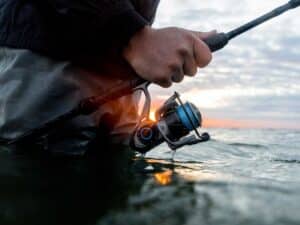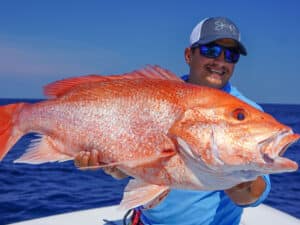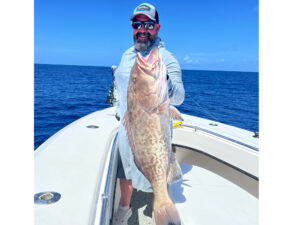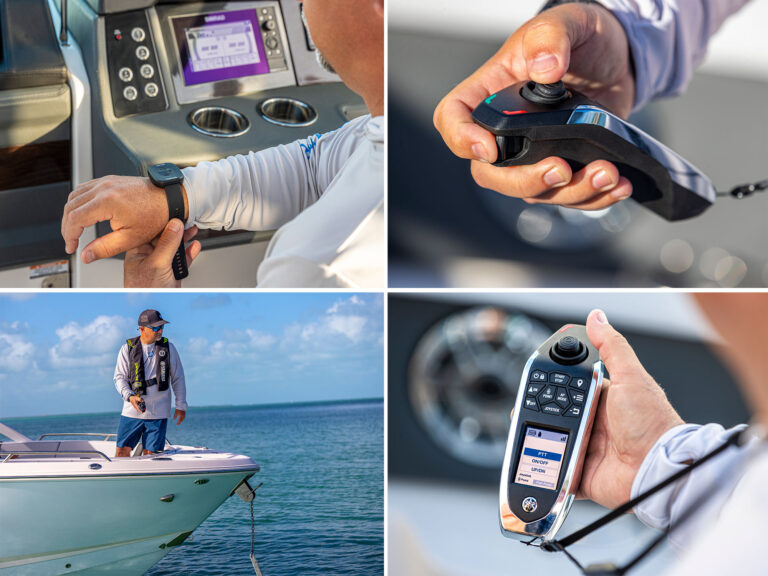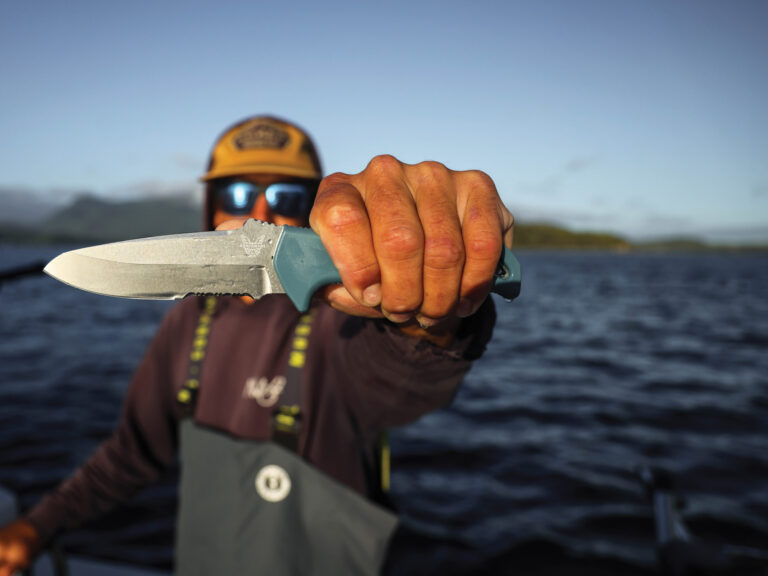
The new high-efficiency, direct-injection outboards have been a huge boon to those of us who spend a lot of time on the water, for many reasons. Even though this new technology adds more to the price tag, we end up saving money at the fuel dock. As an added bonus, the new engines are far less polluting than older designs.
Until now, direct-injected outboards have only been available in configurations up to 225 horsepower. Both Evinrude (FICHT Ram Injection) and Mercury (Opti-Max), offer a 225, and Yamaha’s HPDI currently extends up to 200 hp. All of these companies plan higher horsepower versions, but OMC has gotten there first with the introduction of its new 250-hp Evinrude FICHT Ram Injection V6. This is great news for owners of today’s multitude of large outboard boats, because now they have the power to push their boats more efficiently while realizing big fuel savings at the same time.
**
Totally New Design
**
When it came to building the new 250, OMC didn’t just tweak an existing engine to wring a few more ponies out of it. This is a totally new design, with a larger 90-degree block and many redesigned internal components that are intended to increase performance, efficiency, reliability and durability. The new block is loop-charged and has a 3.3-liter, 200-cubic-inch displacement. OMC says it will improve fuel economy up to 35 percent over conventional outboards, while also cutting oil consumption in half and reducing hydrocarbon emissions by up to 88 percent.
“Offshore boaters will find Evinrude’s FICHT Ram Injection technology offers exceptional overall performance, including turn-key starts, quieter and virtually smoke-free operation, and better, more responsive power on demand to handle rough sea conditions,” said Bob Gowens, president of OMC’s North American Engine Operations. “These new outboards will exceed boaters’ expectations for performance, while at the same time meeting their demands for better fuel economy to make long runs to popular fishing grounds more economical.”
SWS can attest to the performance this new block provides. We recently spent a day at OMC’s test facility in Stuart, Florida, where we ran the 250 Evinrude on a wide variety of boats, in both single and twin installations. The engine’s smoothness and quiet operation impresses you immediately. It sounds much like a smaller four-stroke outboard at idle, and shifts effortlessly and quietly – no clunking or grinding of gears here. But the real story is performance at speed. The engine’s mid-range power curve is extraordinary, with lots of torque available over 4000 rpm, providing excellent acceleration at any speed.
Robin Senger, OMC’s Manager of Applications Engineering, told us about the many technological improvements the new 250 brings to the market. “We had several criteria in mind when we went to the drawing board for the 3.3-liter block,” Robin explained. “We wanted better performance than the competition, whose direct-injection outboards barely meet their stated horsepower. We wanted to have extra horsepower available.
“We also wanted to enhance reliability and durability by providing better heat dissipation,” Robin continued, “and to get the extra torque we wanted, we decided to go with a bigger bore.”
**
How They Did It
**
Robin described to us the exhaustive process OMC went through, starting with a clean sheet of paper and redesigning the entire block, as well as exhaust ports, the cooling system – the works. This block bears little internal resemblance to its predecessors. For example, it features new load-balanced pistons with a solid skirt design for added strength. Gone are the intake-port openings, and OMC also lowered the wrist pin by half an inch to reduce loading on ring land. The connecting rod was therefore shortened, and beefed up with larger rod screws and a thicker joint surface. It has a retained wrist pin bearing, whereas the older engine had loose needle bearings. All this adds up to longer bearing life and increased durability.
The cylinder sleeves now have bottom-feed transfer ports instead of finger ports, so the sleeves have a continuous surface and are stronger. This redesign of the cylinders, which includes a redesigned and balanced crankshaft and new flywheel, results in much lower noise and vibration, and a vast reduction in harmonic resonance.
An all-new cooling system supplies water at the bottom and center of the exhaust covers to cool the exhaust runner, and Robin explained to us that the increased water flow through the cylinder heads helps to carry away heat in a hurry. A high-flow blow-off assembly provides maximum cooling flow during high-load running.
| Horsepower Highlights: * Totally new block * Reduced oil consumption * Lower emissions * More fuel-efficient |
At the tops of the cylinders, the FICHT Ram Injection system uses Sagem toe-seat injector nozzles that were specifically designed for outboard-engine use, and deliver fuel at over 450 psi. OMC found that these injectors were sending the atomized charge of fuel directly at the spark plug electrode, causing lots of heat buildup at the tip of the plug and greatly shortening plug life. A unique fuel deflector was designed into the cylinder head, diverting fuel from directly hitting the electrode, and at the same time enhancing complete combustion.
Electromagnetic, solenoid-driven injector pumps (the heart of the FICHT system) are controlled by a microprocessor-based engine-management system, and deliver short bursts of fuel directly into the combustion chamber at rates of up to 100 times a second. The high-pressure pulse atomizes each fuel burst and positions it properly for burning, and because the exhaust port is closed when the fuel charge reaches the piston, unburned fuel can’t escape through the exhaust port. A separate oiling system injects precise amounts of oil directly into the engine at several lubricating points. Any unused oil is returned to the boat’s reservoir.
A new single-point entry system makes rigging a whole lot easier since cables, hoses and wires – including oil supply and return lines, fuel hose, throttle and shift cables, battery cables, and electrical wires – all enter the same port on the same side of the engine. The electrical system is powered by a double-wound stator located under the flywheel, instead of a belt-driven alternator that can rob the engine of horsepower. The stator provides 35 amps.
The new 3.3-liter block comes in three different horsepower versions: 200, 225 and 250 hp. The 200-hp engine is available in 20- and 25-inch shaft lengths, the 225 in 20-, 25- and 30-inch lengths, and the 250 in 25- and 30-inch lengths. The new engines are relatively light, too. The 25-inch-shaft models weigh about 512 pounds, and that’s pretty good for a direct-injected outboard. OMC also redesigned the pinion gears in the lower unit. The teeth of the new gear should be stronger due to the use of a larger radius at the root of the gear, which should increase the durability of the gearcase.
Owners of 30-foot-plus outboard boats that need twin 250-hp engines will welcome the new Evinrude with open arms, as it will make trips to the fuel dock much less painful. The same goes for owners of smaller fishing boats for which a single 250 is appropriate. But fuel economy is only one part of the story, because the excellent performance, quietness and smooth operation of the new engine make it a complete package that’s hard to beat.
Other outboard companies will surely introduce higher horsepower versions of their own direct-injection engines soon, and OMC is already hinting that the 3.3-liter block will be offered down the road with more horsepower yet. As consumers, it’s fun to sit back and watch all this competition, because we’ll eventually be the winners.
For more information on the new 250-hp Evinrude, contact OMC, (888) 909-4662, or visit the OMC web site at www.omc-online.com.

